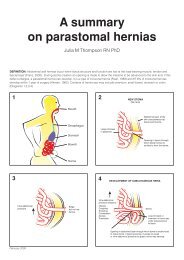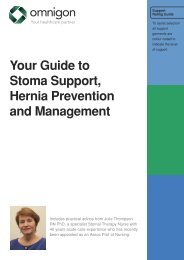Parastomal hernias revisited - Omnigon - Stoma Support Garments
Parastomal hernias revisited - Omnigon - Stoma Support Garments
Parastomal hernias revisited - Omnigon - Stoma Support Garments
Create successful ePaper yourself
Turn your PDF publications into a flip-book with our unique Google optimized e-Paper software.
<strong>Parastomal</strong> <strong>hernias</strong> <strong>revisited</strong>:<br />
a cost-effectiveness analysis<br />
Is an ounce of prevention really<br />
worth a pound of cure?<br />
Assoc Prof Julia Thompson RN PhD<br />
March 2009
Why…<strong>revisited</strong>?<br />
Thompson J and Jack L 1994 <strong>Parastomal</strong> Hernias<br />
JSTA 14 (4): 20-3.<br />
Concluded with some unanswered questions about parastomal <strong>hernias</strong>:<br />
1. What is the incidence?<br />
2. Are there any other measures a surgeon may take?<br />
3. Should stomal therapists be encouraging more people to wear support<br />
binders/corsets as a preventative measure?<br />
4. Should corsets have a hole for the appliance?<br />
5. Are there any other conservative measures available?
Definition<br />
…‘tissue structure and function are lost at the load-bearing muscle,<br />
tendon and fascial level’ (Franz, 2008)
Incidence<br />
Data vary – non-standardization<br />
Carne et al (2003) meta-analysis concluded:<br />
4.0 - 48.1% end colosotmies<br />
0 - 30.8% loop colostomy<br />
1.8 - 28.3 % end ileostomies<br />
0 - 6.2% loop ileostomies<br />
A review of 16,470 on the American United<br />
Ostomy Association Register revealed 30%<br />
incidence over all types of stomas (cited in Gray et al,<br />
2005).
Subtypes (Devlin,1983)<br />
Classification helps describe <strong>hernias</strong> seen on CT scans.
There is gross small bowel obstruction due to a<br />
parastomal hernia (large arrow). Note the presence of gas<br />
within the proximal bowel wall (curved arrows) and portal<br />
vein (small arrow) in b.
Diagnosis<br />
Clinical examination – digital + Valsalva<br />
- upright and supine<br />
Careful history – asymptomatic swelling<br />
- mild discomfort, dull ache/dragging<br />
- nausea<br />
- gradual enlargement hernia and stoma aperture<br />
- difficulty with appliances<br />
- anxiety, distress,<br />
psychological problems<br />
CT or x ray with oral contrast
Possible complications<br />
Intermittent obstruction<br />
Skin ulceration and<br />
infection<br />
Incarceration<br />
Strangulation<br />
Perforated bowel<br />
Ineffective irrigation<br />
Back pain<br />
Exacerbation of<br />
respiratory problems
Intrinsic<br />
- Abnormal collagen metabolism<br />
genetic<br />
acquired<br />
- Age<br />
- Wound breakdown<br />
- Obesity<br />
- Smoking<br />
- Raised intra-abdominal<br />
pressure (chronic constipation,<br />
COAD, prostatism, ascites)<br />
- Mechanical strain e.g. weight<br />
lifting<br />
Risk factors<br />
Extrinsic<br />
Previous hernia repair<br />
Emergency surgery?<br />
Location of stoma?<br />
Trephine size?<br />
Fascial fixation?<br />
Closure lateral space?<br />
Intra or extraperitoneal?<br />
<strong>Stoma</strong> siting by STN?
Management<br />
Best treatment = remove the stoma<br />
… risk of incisional hernia in old stoma site!<br />
Commonest – conservative (support device)<br />
Surgery – avoided due to high recurrence rate<br />
Indications – obstruction, strangulation,<br />
leakages +++<br />
Relative indications – recurrent pain, cosmesis
Nursing management ?<br />
(Gray et al 2005 review of literature)<br />
No proper studies – expert opinion and clinical experience<br />
Modify appliance<br />
Education about what to do if incarceration /strangulation<br />
Regular visits for monitoring<br />
If problems with irrigation – stop performing procedure<br />
Education about how to maintain soft stool with diet / fluids<br />
Application of hernia support belts<br />
Education that hernia must be reduced when support applied<br />
<strong>Support</strong> belts custom fit – hole or no hole? Contentious issue
Surgical options<br />
Local tissue repair<br />
<strong>Stoma</strong> relocation<br />
Repair with mesh – intraperitoneal<br />
- preperitoneal<br />
- fascial overlay mesh repair<br />
Laparoscopic repair<br />
Results generally poor – recurrences++<br />
Full review – Israelsson , 2008.
Surgical prevention<br />
1 study cited in Israelsson,2008<br />
“large pore mesh with reduced polypropylene and<br />
high proportion of absorbable material placed in<br />
sublay position at primary operation”<br />
Other surgeons have their little “tricks” e.g. purse<br />
string sutures around stoma
Conservative Prevention<br />
Thompson & Trainor, 2005<br />
Compared 2 groups for incidence of<br />
hernia development<br />
Retrospective – without treatment<br />
Prospective – with:<br />
Discharge instructions not to lift<br />
heavy objects for 3 months<br />
At 3 months instructed re<br />
abdominal exercises and<br />
encouraged to wear support<br />
belts when lifting<br />
Incidence Group 1: 33%<br />
Group 2: 15%
<strong>Support</strong> garments
<strong>Support</strong> belts
Hole or no hole ?
Hole or no hole ? (2)
Cost-effectiveness analysis<br />
(outcomes can be left in natural units)<br />
Costs of having a parastomal hernia<br />
Psychological – embarrassment / worry<br />
Social – withdrawal / lost opportunities<br />
Economic – new clothes / laundry / new appliances / time<br />
off work to see STN<br />
Physical – discomfort / pulling / dragging<br />
back pain / exacerbation respiratory problems /<br />
intermittent obstruction /strangulation / perforation
Cost of appliances<br />
Extra appliances needed due to changes in size ,shape, location<br />
of stoma and surrounding contours and also due to leakages.<br />
Aust Govt Dept Health and Ageing (Feb 2008)Pricing Guidelines <strong>Stoma</strong><br />
Appliance Scheme Consultation Paper<br />
Simplest appliances 1 piece closed $2.31 $3.45<br />
drainable $5.51 $7.95<br />
urostomy $3.92 <br />
Accessories (<strong>Stoma</strong> Appliance Scheme Schedule Jan 2009)<br />
$9.04<br />
Belt $ 5.57<br />
Paste / tube $ 10.72<br />
Seals (each) $ 4.22<br />
Barrier wipes (each) $ 1.00<br />
Tapes $ 1.10 $12 per roll depending on width<br />
Frames $ 1.36 each
Cost-effectiveness analysis<br />
Prevention Program<br />
Costs (SAS Lists Jan 2009)<br />
<strong>Support</strong> pants $341.97pa<br />
Belts $126.64 $202.32pa<br />
Visits to STN X 3-4 pa<br />
patient time (off work) $ ?<br />
STN time $200<br />
Patient time to perform<br />
exercises daily<br />
Benefits<br />
Thompson & Trainor (2005)<br />
showed drop in hernia<br />
devt from 33% to 15%<br />
Stop smoking, regular<br />
exercises, avoid lifting, –<br />
general health benefit<br />
Feel more comfortable when<br />
wearing the garments
Cost-effectiveness analysis<br />
Surgical repair<br />
Costs – Financial vary greatly according to surgeon and hospital<br />
(Nov 2008 Australian Private Hospital Procedure Banding List)<br />
Simple repair – surgeon $481.55 + assistant $48.15 (ie 10%)<br />
Complex repair – surgeon $845.30 + assistant $84.53<br />
Refashioning stoma – surgeon $540 + assistant $54.90<br />
Anaesthetic depends on length of procedure, complexity of anaesthetic<br />
and age of patient eg for person
Cost-effectiveness analysis<br />
Surgical repair<br />
Costs<br />
Anaesthetic risk of morbidity<br />
Success rate of repairs is notoriously poor<br />
Hernia repair risk of further hernia and other<br />
complications<br />
Benefits<br />
Lifesaving if obstructed/strangulated<br />
Appliance adherence<br />
Back and respiratory problems improve
Joe: born 1960 Crohn’s disease<br />
1983 - Proctocolectomy end ileostomy<br />
14 bowel obstructions (adhesions) since then<br />
1984 – stoma resited due to hernia<br />
1999 – Cholecystectomy<br />
2003 – <strong>Parastomal</strong> abscess, septic arthritis<br />
2004 – division adhesions, small bowel resection (fistula in<br />
ileostomy). Repair ventral hernia and new stoma on<br />
right. Mesh overlay on midline wound and on old stoma<br />
site.<br />
2007 – Laparotomy, reduction and repair of parastomal<br />
hernia , stoma refashioned + mesh overlay
Susan: born 1944: Diverticular disease<br />
1994 sigmoid colectomy Loop colostomy<br />
1995 closure transverse colostomy + debridement<br />
umbilicus. Diarrhoea +++ for 6 months.<br />
Laparotomy, division adhesions +++ and<br />
formation of ileostomy<br />
1998 RIF pain – early parastomal hernia<br />
Surgeon noted: ‘These are almost inevitable and<br />
do not respond well to surgery’
Susan (2)<br />
1998 Repair v large hernia<br />
<strong>Parastomal</strong> incision – ileostomy mobilized<br />
Marlex mesh to outside of fascia<br />
Resutured. Note v weak muscles laterally.<br />
1999 – endoscopist notes large hiatus hernia<br />
2004 Ventral hernia repair with mesh Sac excised,<br />
V dense adhesions. Closed + mesh overlay.<br />
Ampicillin powder.
Susan (3)<br />
Post operative wound infection needed home<br />
nursing visits then readmission for redebridement<br />
of infected wound and packing.<br />
Dec 2005 – removal of infected mesh<br />
Hernia popped out again – many problems<br />
needing maxi bags to adhere. Gap filler.<br />
Now wearing support garments. Does not want to<br />
have further surgery... ever!
George: born 1935 Ca rectum<br />
1980 – APE + end colosotmy<br />
2000 – very large hernia repaired with mesh<br />
overlay. Despite precautions became infected<br />
had to be removed months later.<br />
Leaking appliances +++ “about 5 years”<br />
2005 – visit to STN clinic – reclusive,<br />
obese, severe back problems<br />
refused support garments<br />
2006 – microdiscectomy<br />
2007 – gastric banding + support garments
Tools or toys?<br />
Are we playing or do these things really work ?<br />
Surgeons are doing their best to get a technique<br />
that is successful – ‘need more published series<br />
with bigger numbers’..<br />
Are we (STNs) doing our ‘bit’? Is it enough just<br />
to get a support garment or does it need to be<br />
accompanied by exercises and education about<br />
avoidance of risk factors?... ‘need more<br />
published series with bigger numbers’




